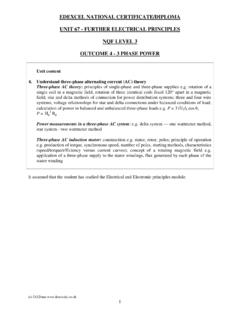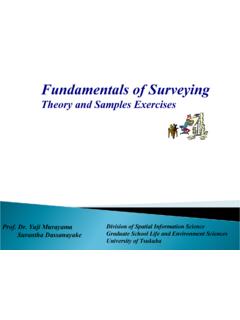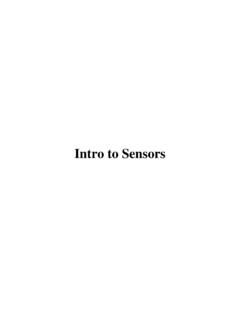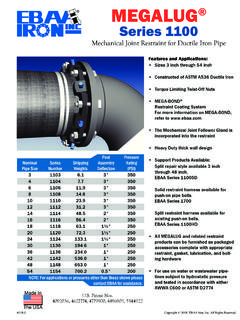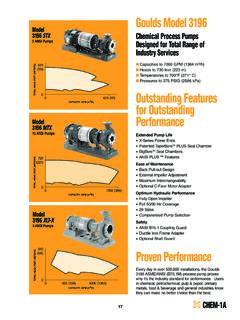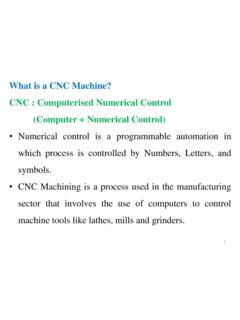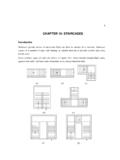Transcription of SOLID MECHANICS DYNAMICS TUTORIAL –NATURAL …
1 1 SOLID MECHANICS DYNAMICS TUTORIAL NATURAL VIBRATIONS ONE DEGREE OF FREEDOM This work covers elements of the syllabus for the Engineering Council Exam D225 DYNAMICS of Mechanical Systems, C105 Mechanical and Structural Engineering and the Edexcel HNC/D module Mechanical Science. Oscillations with two degrees of freedom are covered in other tutorials and these are vital for those sitting exam D225. On completion of this TUTORIAL you should be able to do the following. Explain the meaning of degrees of freedom . Define and explain Simple Harmonic Motion. Explain the meaning of free vibrations.
2 Show how various systems vibrate with simple harmonic motion. Determine the natural frequency and periodic time for simple systems. Determine the displacement, velocity and acceleration of bodies vibrating with simple harmonic motion. Explain the use of energy to analyse vibrations (Rayleigh s Method) Explain how to combine several natural frequencies (Dunkerley s Method) This TUTORIAL covers the theory of natural vibrations and brings together other areas of studies in the process. To do the TUTORIAL fully you must be familiar with the following concepts. Spring Force.
3 Inertia. Moment of inertia. Moment of force. Law s of motion. Basic calculus. The deflection of beams. The twisting of shafts. Strain energy. Buoyancy. All these topics may be found in other tutorials. 2 Contents 1. Free Vibrations Degrees of Freedom Free Vibrations - Examples Simple Harmonic Motion. angular Frequency, Frequency and Periodic Time. Equations of Simple harmonic Motion. 2. Analysis of Natural Vibrations. 3. Simple Pendulum. 4. Linear Elastic Vibrations. Mass-Spring System Transverse Vibrations (of beams) Energy Methods (Rayleigh) Transverse Vibrations due to the distributed mass.
4 Combination of Distributed and Point Loads (Dunkerley) 5. Torsional Oscillations. 6. Oscillation of a Floating Body 1. FREE VIBRATIONS DEGREES OF FREEDOM 3 The numbers of degrees of freedom that a body possesses are those necessary to completely define its position and orientation in space. This is useful in several fields of study such as robotics and vibrations. Figure 1 Consider a spherical object that can only be positioned somewhere on the x axis. This needs only one dimension, x to define the position to the centre of gravity so it has one degree of freedom.
5 If the object was a cylinder, we also need an angle to define the orientation so it has two degrees of freedom. Now consider a sphere that can be positioned in Cartesian coordinates anywhere on the z plane. This needs two coordinates x and y to define the position of the centre of gravity so it has two degrees of freedom. A cylinder, however, needs the angle also to define its orientation in that plane so it has three degrees of freedom. Figure 2 In order to completely specify the position and orientation of a cylinder in Cartesian space, we would need three coordinates x, y and z and three angles relative to each angle.
6 This makes six degrees of freedom. In the study of free vibrations, we will be constrained to one degree of freedom. Figure 3 FREE VIBRATIONS- EXAMPLES A free vibration is one that occurs naturally with no energy being added to the vibrating system. The vibration is started by some input of energy but the vibrations die away with time as the energy is dissipated. In each case, when the body is moved away from the rest position, there is a natural force that tries to return it to its rest position. Here are some examples of vibrations with one degree of freedom. Figure 4 Note that the mass on the spring could be made to swing like a pendulum as well as bouncing up and down and this would be a vibration with two degrees of freedom.
7 The motion that all these examples perform is called SIMPLE HARMONIC MOTION ( ). This motion is characterised by the fact that when the displacement is plotted against time, the resulting graph is basically sinusoidal. Displacement can be linear ( the distance moved by the mass on the spring) or angular ( the angle moved by the simple pendulum). Although we are studying natural vibrations, it will help us understand if we study a forced vibration produced by a mechanism such as the Scotch Yoke. SIMPLE HARMONIC MOTION 4 Figure 5 Figure 6 The wheel revolves at radians/sec and the pin forces the yoke to move up and down.
8 The pin slides in the slot and Point P on the yoke oscillates up and down as it is constrained to move only in the vertical direction by the hole through which it slides. The motion of point P is simple harmonic motion. Point P moves up and down so at any moment it has a displacement x, velocity v and an acceleration a. 5 The pin is located at radius R from the centre of the wheel. The vertical displacement of the pin from the horizontal centre line at any time is x. This is also the displacement of point P. The yoke reaches a maximum displacement equal to R when the pin is at the top and R when the pin is at the bottom.
9 This is the amplitude of the oscillation. If the wheel rotates at radian/sec then after time t seconds the angle rotated is = t radians. From the right angle triangle we find x = R sin( t) and the graph of x - is shown on figure 7a. Velocity is the rate of change of distance with time and in calculus form v = dx/dt. If we differentiate x we get v = dx/dt = R cos( t). The plot is also shown on figure 7a. The maximum velocity or amplitude is R and this occurs as the pin passes through the horizontal position and is plus on the way up and minus on the way down. This makes sense since the tangential velocity of a point moving in a circle is v = R and at the horizontal point they are the same thing.
10 Acceleration is the rate of change of velocity with time and in calculus form a = dv/dt. Differentiating v we get a = dv/dt = - 2R sin( t). The plot is also shown on figure 7a. The amplitude is 2R and this is positive at the bottom and minus at the top (when the yoke is about to change direction) Since R sin( t) = x then substituting x we find a = - 2x This is the usual definition of The equation tells us that any body that performs sinusoidal motion must have an acceleration that is directly proportional to the displacement and is always directed to the point of zero displacement.









